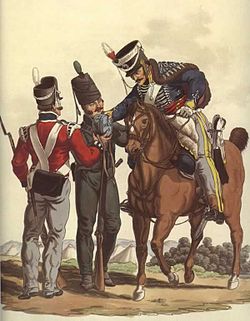
Back Кралски германски легион Bulgarian King’s German Legion German King's German Legion Spanish لژیون آلمانی پادشاه Persian King's German Legion French הלגיון הגרמני של המלך HE King's German Legion Italian King's German Legion Dutch King’s German Legion Polish King's German Legion Portuguese
| King's German Legion | |
|---|---|
 A line infantryman, light infantryman and hussar of the King's German Legion | |
| Active | 1803–1816 |
| Country | Electorate of Hanover; since 1814 Kingdom of Hanover |
| Branch | British Army |
| Type | Artillery Cavalry Line infantry Light infantry |
| Size | approximately 14,000 [1] |
| Garrison/HQ | Infantry at Bexhill-on-Sea Cavalry at Weymouth, Dorset |
| Battle honours |
|
| Commanders | |
| Notable commanders | |

The King's German Legion (KGL; German: Des Königs Deutsche Legion) was a British Army formation consisting of expatriate German soldiers which existed from 1803 to 1816. It achieved the distinction of being the only German military force to fight without interruption against the French and their allies during the Napoleonic Wars.
Formed within months of the dissolution of the Electorate of Hanover in 1803, the Legion was constituted as a mixed corps by the end of the year. Although the KGL never fought autonomously and remained a part of the British Army during the rest of the Napoleonic Wars, it played a vital role in several campaigns, most notably the Peninsular War, the Walcheren Campaign and the Hundred Days.
The Legion was disbanded in 1816. Many KGL units were incorporated into the Hanoverian Army, and became later a part of the Imperial German Army after the unification of Germany into the German Empire 1871. The British German Legion, recruited for the Crimean War, has sometimes been erroneously referred to as the "King's German Legion".[citation needed]
- ^ Chapell vol. 1, p. 10